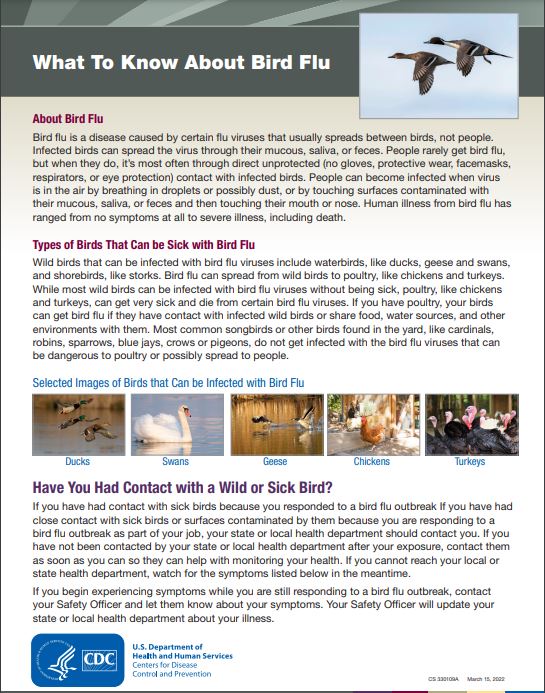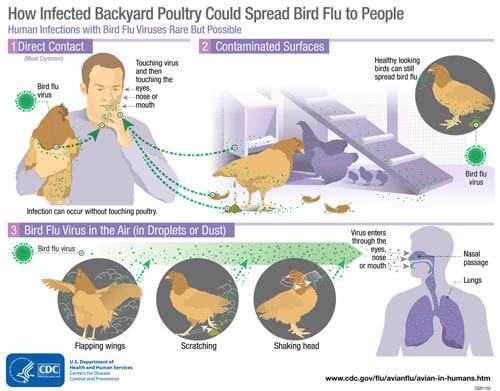Bird Flu Virus Infections in Humans
Español | Other Languages
On This Page
- Signs and Symptoms of Avian Influenza A Virus Infections in Humans
- Detecting Bird Flu Avian Influenza A Virus Infection in Humans
Although avian (bird) influenza (flu) A viruses usually do not infect people, there have been some rare cases of human infection with these viruses. Illness in humans from bird flu virus infections have ranged in severity from no symptoms or mild illness to severe disease that resulted in death. Asian lineage H7N9 and highly pathogenic avian influenza Asian lineage H5N1 viruses have been responsible for most human illness from bird flu viruses worldwide to date, including the most serious illnesses and illness with the highest mortality.
Infected birds shed bird flu virus through their saliva, mucous and feces. Human infections with bird flu viruses can happen when virus gets into a person’s eyes, nose or mouth, or is inhaled. This can happen when virus is in the air (in droplets or possibly dust) and a person breathes it in, or possibly when a person touches something that has virus on it then touches their mouth, eyes or nose. Human infections with bird flu viruses have occurred most often after unprotected contact with infected birds or surfaces contaminated with bird flu viruses. However, some infections have been identified where direct contact with infected birds or their environment was not known to have occurred.
The spread of bird flu viruses from one infected person to a close contact is very rare, and when it has happened, it has only spread to a few people. However, because of the possibility that bird flu viruses could change and gain the ability to spread easily between people, monitoring for human infection and person-to-person spread is extremely important for public health.
Spread of Bird Flu Viruses Between Animals and People
Prevention and Antiviral Treatment of Bird Flu in People
Examples of Possible Human to Human Transmission
Reported Human Infections with Bird Flu
What To Know About Bird Flu

What To Know About Bird Flu pdf icon[154 KB, 2 pages]

Avian Influenza Transmission Infographic pdf icon[555 KB, 2 pages]
Spanish pdf icon[531 KB, 2 pages]
Simplified Chinese pdf icon[581 KB, 2 pages]
Signs and Symptoms of Avian Influenza A Virus Infections in Humans
The reported signs and symptoms of bird flu virus infections in humans have ranged from no symptoms or mild illness [such as eye redness (conjunctivitis) or mild flu-like upper respiratory symptoms], to severe (such as pneumonia requiring hospitalization) and included fever (temperature of 100ºF [37.8ºC] or greater) or feeling feverish*, cough, sore throat, runny or stuff nose, muscle or body aches, headaches, fatigue, and shortness of breath or difficulty breathing. Less common signs and symptoms include diarrhea, nausea, vomiting, or seizures.
*Fever may not always be present
Detecting Bird Flu Avian Influenza A Virus Infection in Humans
Bird flu virus infection in people cannot be diagnosed by clinical signs and symptoms alone; laboratory testing is needed. Bird flu virus infection is usually diagnosed by collecting a swab from the upper respiratory tract (nose or throat) of the sick person. Testing is more accurate when the swab is collected during the first few days of illness.
For critically ill patients, collection and testing of lower respiratory tract specimens also may lead to diagnosis of bird flu virus infection. However, for some patients who are no longer very sick or who have fully recovered, it may be difficult to detect bird flu virus in a specimen.
CDC has posted guidance for clinicians and public health professionals in the United States on appropriate testing, specimen collection, and processing of samples from patients who might be infected with avian influenza A viruses.
Top of Page
Page last reviewed: March 10, 2022
